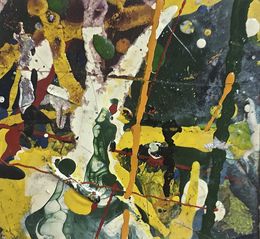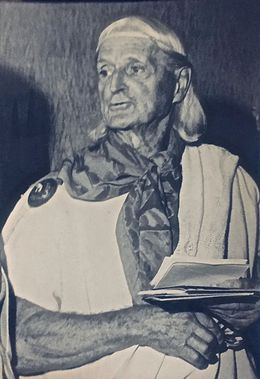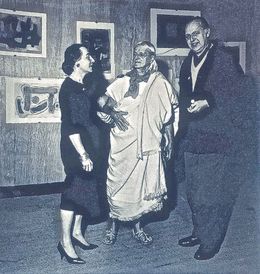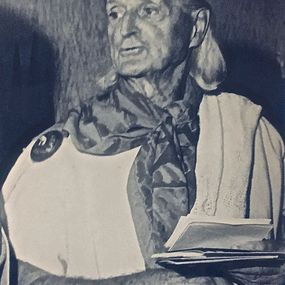
Presentation
Raymond Duncan (1874-1966) is an American painter and complete artist belonging to the Ecole de Paris, since he was born in San Francisco, USA, but settled in Paris and died in France in 1966.
Lise Cormery wrote the biography of Raymond Duncan in her book "The Art of the Ecole de Paris". "This "litterati" painter and writer, poet also created as well printing fonts, the Duncan, used for the books of his publishing company as well as for his magazines, "Exangelos" and "Paris Programme", the ancester of Pariscope. Decorator, designer of furnitures and art objects, he was a choreographer and a classical dancer, besides he was vegetarian and the champion of the animal cause. Duncan was not egocentric like most artists, but very altruistic and helped artists in need. As soon as 1903 he gives up the western outfits and creates the design as well as the looming of his art textiles, he wears ancestral Greek gowns and his famous sandals, that will become over the years very fashionable for the international Jet Set. Gandhi will buy him his weaving loom, that will become the symbol of the political autonomy of India, freed from the English Trade dictatorship. During the Great War of 1914-1918, more than 10 000 people will use his free classes and textile studio in order to weave their own clothing, since Parisians suffered of terrible shortages.
Thanks to the expertise of a curator of an American Museum collecting ancient Greek carpets he thought without value, he can buy in 1911 the 31, rue de Seine. But, at that time, rue de Seine had to be destroyed by Paris City Hall.
In the spirit of the "Plato Academy" he creates an international Cultural Center for theater, dance, music, textile arts, with an art printing press, a publishing company for numerous books and authors, as well as his magazine "Exangelos" and "Paris Programme", "Pariscope" ancestor.
He opens an Avant-Garde Art Gallery for international artists. In order to promote their art he creates "Le Prix de New-York", "New-York Prize" and offers Solo Shows in Gallery Raymond Duncan, 303, East 51st Street, New-York, for Kam Zin Choon, Lu Choon Min and Billard, etc.
Married to Pénélope Sikelianou, a Greek dying at a very early age in 1917, they have a daughter, Ligoa, and a son, Menalkas. They live first near Athens where Duncan creates all the furniture and works of art of their home, before they settle for ever in Paris. During the 1912-1913 Balkan War, he opens in Greece a Center to help refugees. During the Great War of 1914-1918 he creates in Nice, France, a school for the rehabilitation of injured soldiers. This is in Nice, that his sister, the famous International Dancer and Star Isadora Duncan died in 1927, strangled by her own scarf while driving her convertible car. As a Tribute, he creates in Akademia a famous Dancing School. When Raymond Duncan dies "Le Monde" salutes with emotion the artist Raymond Duncan, since his whole life was Art!"


Raymond Duncan Autoportrait Self-Portrait
Raymond Duncan
Photography - 18 x 13 cm Photography - 7.1 x 5.1 inch
£1,752

1952 Raymond DUNCAN Galerie Akademia
Raymond Duncan
Photography - 18 x 13 cm Photography - 7.1 x 5.1 inch
£2,606

1952 Raymond DUNCAN dans sa galerie Akademia
Raymond Duncan
Photography - 18 x 13 cm Photography - 7.1 x 5.1 inch
£2,651
Discover our selections of works by artists
What are their 3 main works?
When was Raymond Duncan born?
